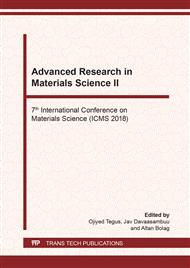p.1
p.9
p.17
p.27
p.37
p.44
p.51
p.59
Effect of Moisture Content on the Diverse Structure State of the Octanoyl Alanine Metal (Mg, Ca) Complexes
Abstract:
Octanoyl alanine ligands and metal ions (Mg2+, Ca2+) form metal complexes of octanoyl alanine through chemical coordination bonds [1]. According to the acid base reaction and the Lewis acid-base theory[2], the molecule or ion of the central atom or ion (collectively called the central atom) and the ligand (called ligand) around it, completely or partially by the coordination bond to form metal complex. These octanoyl alanine complexes are soluble in water and easily ionize into internal coordination ions and external ions, while the ligands and central atoms do not ionize in the inner boundary. The octanoyl alanine magnesium and calcium complexes belongs to the amino acid metal complexes, which can be widely used in daily life, industrial production and life science in the future application. Recently, with the rapid development of amino acid metal complexes [3-7], it is not only associated with inorganic compounds and organometallic compounds, but also overlaps with the chemistry, coordination catalysis and molecular biology of the current chemical frontiers [8-10]. In this paper, [C10H20NCO3]2M type metal complexes prepared by combining octanoyl alanine ligand with metal ions containing functional group COOH, the influence of water content on the DSC curve and surface morphology of metal complexes was studied, and the information of the diversified structure state of the materials complex can be obtained.
Info:
Periodical:
Pages:
1-8
Citation:
Online since:
March 2019
Authors:
Keywords:
Price:
Сopyright:
© 2019 Trans Tech Publications Ltd. All Rights Reserved
Share:
Citation:


